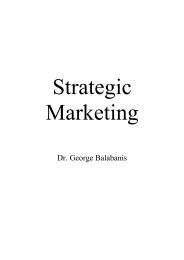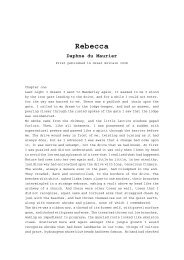Brand Failures
Brand Failures
Brand Failures
Create successful ePaper yourself
Turn your PDF publications into a flip-book with our unique Google optimized e-Paper software.
250 <strong>Brand</strong> failures<br />
recognition as you become identified with whatever you’re selling. You<br />
get a lot of free publicity and customer confidence because you’re the<br />
leader. It’s then very difficult for the second wave to compete. Amazon.<br />
com was a shining example of that. Here was a company that spent<br />
almost nothing on marketing before its IPO, but still managed to create<br />
one of the best known brands in the world.<br />
When boo.com became public knowledge in May 1999, via an article in The<br />
Financial Times, Kasja Leander announced the company in these terms:<br />
‘Sportswear is an international market and there are a lot of people in Europe<br />
who read about products in US magazines but can’t go over to buy them. This<br />
is one of the few sectors of Internet retailing that no one’s done on a large<br />
scale and we want boo to be the number one brand.’<br />
So neither Malmsten nor Leander can be accused of ignoring branding.<br />
The idea, from the start, was to create a ‘fully branded shopping experience<br />
on the Net,’ an online equivalent of high fashion department stores such as<br />
London’s Harvey Nichols or New York’s Bloomingdales, only with the main<br />
focus on urban and sportswear from hip brands such as Adidas, New Balance<br />
and North Face.<br />
However, the brand that really mattered was boo itself. As Malmsten has<br />
explained, the aim was to make ‘the name of the store itself as significant as<br />
anything you could buy in it.’ Again, this displays solid brand-thinking, and<br />
marked boo apart from many other dot.coms that had sprung from the<br />
minds of technologists. But the problem was that whatever it can represent,<br />
the Internet is technology.<br />
If you are going to create what Malmsten referred to as ‘a gateway to world<br />
cool’ (as quoted in a June 2000 Industry Standard article), you need software<br />
to make sure people can access the gateway in the first place. In other words,<br />
your Web site has to work.<br />
On the first day of its eventual launch, 4 November 1999 (two months<br />
after the premature advertising campaign featuring the man vomiting into a<br />
dustbin) the problems with the boo.com Web site soon became apparent.<br />
The site crashed seconds after it went live. And then, when people could finally<br />
access the site, the real headaches, both for boo and its customers, began.<br />
One of these headaches related to the heavy use of Flash software, which<br />
enabled the site to be animated. Indeed, one of the key features of the site<br />
was the virtual shop assistant Miss Boo who was only able to come to life










